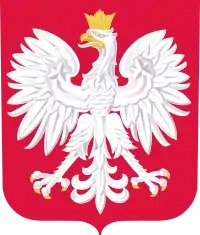National Bank of Poland
Narodowy Bank Polski (National Bank of Poland, NBP) is the central bank of Poland. It controls the issuing of Poland's currency, the złoty. The Bank is headquartered in Warsaw, and has branches in 16 major Polish towns. The NBP represents Poland in the European System of Central Banks, an EU organization.
| |||
| Headquarters | Warsaw | ||
|---|---|---|---|
| Established | 1945 | ||
| Ownership | 100% state ownership[2] | ||
| President | Adam Glapiński | ||
| Central bank of | Poland | ||
| Currency | Złoty PLN (ISO 4217) | ||
| Reserves | $89.420 billion[2] | ||
| Preceded by | Bank of Poland (1828 and 1918) | ||
| Website | Narodowy Bank Polski official site (in Polish and English) | ||
History
Although the bank has existed under its current name since 1945,[1] it is a continuation of two previous central banks of Poland, both named simply Bank of Poland (Bank Polski). The first one was founded in Warsaw in 1828 by Prince Franciszek Ksawery Drucki-Lubecki. An institution of the government of the Kingdom of Poland, it was entitled with issuance of the Polish currency as well as control over the credit rates. It was also entitled with a concession to operate foreign currencies and buy off credits issued by foreign companies and banks.
During the Second World War the gold reserves of Poland were transferred to Romania, Great Britain and Canada. In November 1946, following the cancellation of Polands wartime debt, the larger part of prewar gold reserves were returned to Poland's new communist authorities. In 1947 the gold deposited in Romania in 1939 was returned, while the former Bank of Poland itself was closed down and finally in 1952 absorbed by the newly created Narodowy Bank Polski.
The latter was one of two banks allowed to operate in Poland's postwar planned economy. It had a monopoly for currency, credits and cumulation of savings. The other bank, PKO Bank Polski, was responsible for private accounts. After the fall of the communist system in 1989, the market economy was reintroduced and the NBP limited its functions to currency control and supervision of other, privately controlled banks.
Structure
The structure and functioning of the Narodowy Bank Polski are regulated by article 227 of the Constitution of Poland of 1997 and the Narodowy Bank Polski Act of the same year.[3] The President of the NBP is appointed by the Sejm, at the request of the President of the Republic of Poland, for a term of six years. The NBP President is responsible for the organisation and functioning of the Polish's central bank. The same person cannot serve as President of the NBP for more than two terms of office. Apart from his function as the superior of the NBP staff, he is also the chairman of the Monetary Policy Council, the NBP Management Board and the Commission for Banking Supervision. He is also responsible for representing Poland in international banking and financial institutions.

List of Presidents of the NBP
- Edward Drożniak (1945–1949)
- Witold Trąmpczyński (1950–1956)
- Edward Drożniak (1956–1961)
- Adam Żebrowski (1961–1965)
- Stanisław Majewski (1965–1968)
- Leonard Siemiątkowski (1968–1972)
- Witold Bień (1973–1980)
- Stanisław Majewski (1981–1985)
- (acting) Zdzisław Pakuła (1985)
- Władysław Baka (1985–1988)
- Zdzisław Pakuła (1988–1989)
- Władysław Baka (1989–1991)
- Grzegorz Wójtowicz (1991)
- (acting) Andrzej Topiński (1991–1992)
- Hanna Gronkiewicz-Waltz (1992–2001)
- Leszek Balcerowicz (2001–2007)
- Sławomir Skrzypek (2007–2010)
- (acting) Piotr Wiesiołek (2010)
- Marek Belka (2010-2016)
- Adam Glapiński (Since 2016)
References
- "The history of central banking in Poland". Narodowy Bank Polski. 22 September 2014. Retrieved 11 April 2016.
- https://d-nb.info/1138787981/34
- "Organizacja NBP" (PDF). Ustawa o Narodowym Banku Polskim (in Polish). Narodowy Bank Polski. 29 August 1997. Retrieved 18 April 2013.





